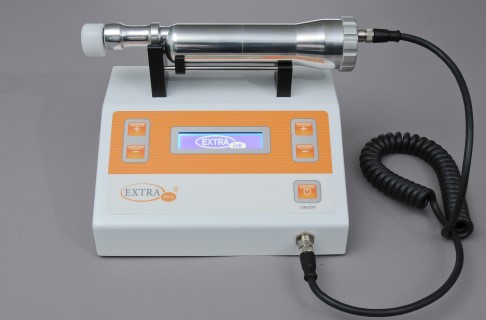Bio Mechanical Stimulation – Battery Supported Handheld Device
The Regeneration through movement & rhythm of muscles with Matrix Therapy

An innovative non-invasive therapy for a variety of different disorders within the musculoskeletal (MSK) system


What is BMS?
BMS is non-invasive externally applied mechanical stimulation of defined amplitude and frequency to the skin, connective tissue and muscles. It is a 100% natural and safe method of imparting the bodies natural rhythms back into the connective tissue, the extracellular matrix and the musculotendinous bone junctions which can be treated by this biomechanical stimulation with the mechanotherapeutic approach of cell biological regulation medicine using the BMS device. Complexly located disorders, imbalances, pain and weakness can be efficiently managed or avoided with BMS matrix therapy and existing therapy combined.
Device specificsHistory of bio-mechanical stimulation therapy – Sport Science. In 1960, Professor Biermann from the University of Sport Science, Leipzig, Germany, researched and published the first bio-mechanical stimulation journal in relation to the human body.
Prof. Biermann In 1960 developed the first BMS device and applied it in sport science, to gymnasts, wrestlers and weightlifters in Eastern Germany during the DDR era. BMS devices increased an athlete’s performance, promoted regeneration and improved extensibility.
Later Prof. V. Nazarov from the USSR, further developed the BMS device and introduced the concept into sport medicine. Whereby in 1976/77, his first experimental devices for BMS were created and, thereafter, these methods were subject to over 20 years of the strictest secrecy. The BMS remained in the hands of the Eastern Bloc sports scientists who used BMS devices for performance enhancement, better regeneration and extensibility. In 1990, Prof. Nazarov introduced the BMS device to West German sport science.
Biography of Prof. V. Nazarov the father of biomechanical stimulation (BMS)


The inventor of biomechanical stimulation, Prof. habil. V. Nazarov, was born on 31st January 1936 in Belorussia.
1954–1959: University education in human anatomy and physiology
1960: Master of Sport in the USSR in apparatus gymnastics
1962–1982: University lecturer, instructor and professor at the Technical University of Riga
1968: Doctor of Sciences
1974: Prof. of Sciences (habilitation)
1976–1986: Professor at the Technical University of Riga
1976–1992: Chairman of the Scientific Council for Biomechanics at the Academy of Sciences of the USSR
1982–1994: Dean, Chair of Biomechanics, Minsk Academy (Biomechanics was the most important Professorship of the Soviet Union)
Since completing his work on new biomechanics Prof. Nazarov was involved with research into muscle vibration. The first experimental apparatus for muscle stretching was constructed in 1976/77. Following this the method was kept top secret for over 20 years. It was only after the political changes that this incredible knowledge also became available in the West.
Siegfried Hofmann, a German sports scientist encountered the BMS concept during a sports event and developed and patented the first BMS device in West Germany.
In 1996, after several years of work, he also created and patented the highly effective and special form of the oscillating head (resonator) in the form of an Archimedean spiral.
The relevance and importance of the Archimedean spiral is because it produces different path speeds at the same angular velocity upon the skin surface. Due to these rolling moments, stretching is relatively proportional to deep tissue, such as the fascia, that is along the length of the fibres and simultaneously stimulates stretch-sensitive organs (the muscle spindle). By stimulating the Golgi tendon organ, muscles associated with α motor neurons are inhibited (self-inhibition = relaxation). This ensures that the tissue’s total receptors can retract and relax, including the proprioceptors (myosin, Golgi). Healthy organisms require calm movements within the body (vagal nerves), and full activation of the vibration range of active movement (sympathetic nerves). These specific harmonic wave forms from the resonator are introduced into the tissues along the course of the muscle fibres via the biomechanical stimulation.
The BMS Therapeutic Apparatus can generate these natural biological vibrations between 5-30Hz in the direction of uniform contraction/stretching of muscles, fascia and other soft tissues through its unique Archimedean spiral, which promotes the release of the extracellular matrix whilst softening the soft tissues. The metabolism can then activate the discharge of inflammatory factors, such as, lactic acid and other metabolic wastes which treats both the symptoms and root causes, and to fundamentally relieve pain. The mechanical stimulus introduced externally into the body via the machine must be consistent with the body’s natural biological vibration model of the muscles to bring about a positive and efficient treatment result.
To date, many and various names have been given to this BMS concept: Bio-Mechanical Stimulation Matrix Therapy, Bio-Mechanical muscle stimulation, Nazarov stimulation, neuromuscular stimulation, matrix rhythm therapy, ZRT, MRT, Matrix Therapy, to name a few.Many doctors have conducted further clinical studies using this concept and have been very successful in the practical application of Bio-Mechanical Stimulation Matrix Therapy.
We are grateful to the pioneering scholars like Pischinger and Hartmut Heine who laid the foundations for BMS and with their work on the regulation of the cell milieu system and the importance and function of the ECM making all this possible.